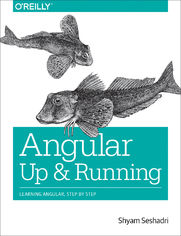Angular: Up and Running. Learning Angular, Step by Step - Helion

ISBN: 978-14-919-9984-4
stron: 312, Format: ebook
Data wydania: 2018-05-31
Ksi─Ögarnia: Helion
Cena ksi─ů┼╝ki: 143,65 z┼é (poprzednio: 167,03 z┼é)
Oszczędzasz: 14% (-23,38 zł)
This book will demystify Angular as a framework, as well as provide clear instructions and examples on how to get started with writing scalable Angular applications.
Angular: Up & Running covers most of the major pieces of Angular, but in a structured manner that is generally used in hands-on training. Each chapter takes one concept, and use examples to cover how it works. Problems to work on (with solutions) at the end of each chapter reinforce the learnings of each chapter and allow readers to really get hands-on with Angular.
Osoby które kupowały "Angular: Up and Running. Learning Angular, Step by Step", wybierały także:
- Angular 2. Programowanie z użyciem języka TypeScript 77,10 zł, (23,90 zł -69%)
- RESTful Web Services. Kurs video. Tworzenie restowych aplikacji internetowych w Spring, AngularJS 79,00 zł, (31,60 zł -60%)
- AngularJS. Kurs video. Poziom pierwszy. Tworzenie aplikacji 119,00 zł, (47,60 zł -60%)
- Angular 11. Kurs video. Poznaj moc tworzenia aplikacji typu SPA 129,00 zł, (58,05 zł -55%)
- Angular 5. Kurs video. Poziom pierwszy. Programowanie webowe w oparciu o architektur─Ö komponentow─ů 129,00 z┼é, (58,05 z┼é -55%)
Spis tre┼Ťci
Angular: Up and Running. Learning Angular, Step by Step eBook -- spis tre┼Ťci
- Introduction
- Who Should Read This Book
- Why I Wrote This Book
- A Word on Web Application Development Today
- Navigating This Book
- Online Resources
- Conventions Used in This Book
- Using Code Examples
- OReilly Safari
- How to Contact Us
- Acknowledgments
- 1. Introducing Angular
- Why Angular
- What This Book Will Not Cover
- Getting Started with Your Development Environment
- Node.js
- TypeScript
- Angular CLI
- Getting the Codebase
- Conclusion
- 2. Hello Angular
- Starting Your First Angular Project
- Understanding the Angular CLI
- Running the Application
- Basics of an Angular Application
- Root HTMLindex.html
- The Entry Pointmain.ts
- Main Moduleapp.module.ts
- Root ComponentAppComponent
- Creating a Component
- Steps in Creating New Components
- Using Our New Component
- Understanding Data Binding
- Understanding Property Binding
- Understanding Event Binding
- Using Models for Cleaner Code
- Conclusion
- Exercise
- 3. Useful Built-In Angular Directives
- Directives and Components
- Built-In Attribute Directives
- NgClass
- NgStyle
- Alternative Class and Style Binding Syntax
- Built-In Structural Directives
- NgIf
- NgFor
- NgSwitch
- Multiple Sibling Structural Directives
- Conclusion
- Exercise
- 4. Understanding and Using Angular Components
- ComponentsA Recap
- Defining a Component
- Selector
- Template
- Styles
- Style Encapsulation
- Others
- Components and Modules
- Input and Output
- Input
- Output
- Change Detection
- Component Lifecycle
- Interfaces and Functions
- View Projection
- Conclusion
- Exercise
- 5. Testing Angular Components
- Why Unit Test?
- Testing and Angular
- The Test Setup
- Karma Config
- test.ts
- Writing Unit Tests
- An Isolated Unit Test
- Running the Tests
- Writing an Angular-Aware Unit Test
- Testing Component Interactions
- Debugging
- Conclusion
- Exercise
- 6. Working with Template-Driven Forms
- Template-Driven Forms
- Setting Up Forms
- Alternative to ngModelEvent and Property Binding
- ngModel
- A Complete Form
- Control State
- Control Validity
- Working with FormGroups
- Conclusion
- Exercise
- Template-Driven Forms
- 7. Working with Reactive Forms
- Reactive Forms
- Understanding the Differences
- Using Reactive Forms
- Form Controls
- Form Groups
- Form Builders
- Form Data
- Control State, Validity, and Error Messages
- Form and Data Model
- FormArrays
- Conclusion
- Exercise
- Reactive Forms
- 8. Angular Services
- What Are Angular Services?
- Creating Our Own Angular Service
- Digging into the Example
- An Introduction to Dependency Injection
- Angular and Dependency Injection
- RxJS and Observables: Moving to Asynchronous Operations
- Conclusion
- Exercise
- 9. Making HTTP Calls in Angular
- Introducing HttpClient
- Server Setup
- Using HttpClientModule
- Making HTTP GET/POST Calls
- Advanced HTTP
- OptionsHeaders/Params
- OptionsObserve/Response Type
- Interceptors
- Advanced Observables
- Conclusion
- Exercise
- Introducing HttpClient
- 10. Unit Testing Services
- How to Unit Test Services
- Testing Components with a Service Dependency
- Testing Components with a Real Service
- Testing Components with a Mock Service
- Testing Components with a Fake Service
- Unit Testing Async
- Unit Testing HTTP
- Conclusion
- Exercise
- 11. Routing in Angular
- Setting Up Angular Routing
- Server Setup
- Starting Codebase
- Importing the Router Module
- Displaying the Route Contents
- Navigating Within the Application
- Wildcards and Defaults
- Common Routing Requirements
- Required Route Params
- Navigating in Your Application
- Optional Route Params
- Route Guards
- Authenticated-Only Routes
- Preventing Unload
- Preloading Data Using Resolve
- Conclusion
- Exercise
- Setting Up Angular Routing
- 12. Productionizing an Angular App
- Building for Production
- Production Build
- Ahead-of-Time (AOT) Compilation and Build Optimizer
- Base Href
- Deploying an Angular Application
- Other Concerns
- Caching
- API/Server Calls and CORS
- Different Environments
- Handling Deep-Linking
- Lazy Loading
- Server-Side Rendering and Handling SEO
- Dependencies
- Making the changes
- Additions for the server side
- Configuration
- Running Angular Universal
- Conclusion
- Building for Production
- Index





